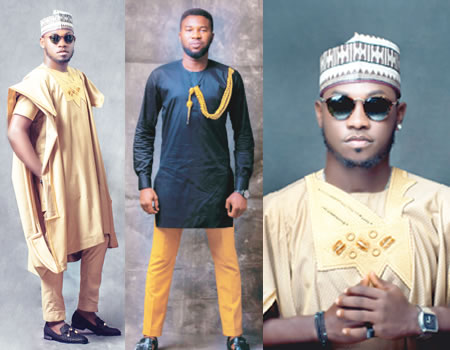Twenty-first-century designers are making menswear outfits less snooze-worthy. Last year, Ebuka Uchendu turned heads and broke the internet at Banky W’s wedding. He stole the spotlight in his modified agbada that almost didn’t look like an agbada.
Now, our terminal economy may not permit you to ludicrously splurge a huge sum – like celebrities do – on an outfit. Howbeit, there are inexpensive ways to leave a mark with the ladies in your traditional attire; you just have to get the styling right.
The Agbada
The classic or modified agbada is an instant status lift; it can transform a pauper into a temporal chairman, with every street lout falling at his feet waiting for him to make money rain on them. This could be you, but the transformation starts with the right tailoring. (Keanvic) has mastered the art of fitting.) Here’s how you can differentiate between an agbada that was constructed by a professional tailor and the one that was made by a cobbler.
The pants are too big or too small.
The pants have to be slim fit and stop just above your ankle. Any shorter will seem like it belongs to your little brother, while a longer length will make you look frumpy.
There’s too much fabric
It’s true that the beauty of the agbada lies in the bulkiness, but you don’t want to feel like you’re carrying the weight of the world on your shoulders anymore. Your agbada should be calf length, that is, four or five inches above your ankle and less bulky than what your ancestors wore.
For the right styling, resist the temptation to be daring and distance yourself from sporty shoes – canvas and trainers. Instead embrace sandals, traditional loafers and lace-less dress shoes.
A cap is usually the icing needed on top of the agbada cake. There are a plethora of traditional caps to choose from; you can wear the Hausa cap- hula, the Yoruba cap – fila, or any structured cap.
The Kaftan
It may look like a basic top and trousers, but the versatility of this outfit cannot be overemphasised; you can wear it to a cookout, to the beach, to a party, and to a formal event. Unlike the agbada which depends on size and volume, the design is king for the Kaftan. The simple cut silhouette comes alive when embroidered, which ranges from simple to over-the-top, complex stitches.
Styling your Kaftan is akin to the agbada, although, you can skip wearing a cap if your aim is simplicity.
In a semi-formal setting like a wedding, avoid casual shoes and opt for dress shoes.
For an informal look, wear sandals or leather slippers.
Buba and Sokoto
The Bubba and Sokoto which when translated means “a top and trousers” have an identical silhouette to the Kaftan (though slight changes may be found with the length of the top). This outfit is a Yoruba attire and deserves to be styled as such. Dependent on the occasion, a Bubba and Sokoto should be styled with fila (Yoruba cap), and neck or wrist beads.
The Danshiki
This attire has been a staple in wardrobes long before it became mainstream, thanks to stars like Chris Brown, Rihanna, Keri Hilson etc. The danshiki is the most fluidal traditional attire. When it comes to styling, you can pair it with jeans and sporty shoes. This attire is the next best thing since sliced bread. The danshiki, like the kaftan, depends on embroidery to stand out, but unlike the agbada and the kaftan, it gives very little coverage to the arm. The short-sleeved, boxy-shaped top leaves enough room for your skin to breathe, making it the perfect choice for our humid weather. But if you are uncomfortable exposing your arms, this is not for you.
Styling tip: there are variations of the danshiki, so the look you’re going for depends on the type you wear. Are you going on a dinner date? Get a tailored dashiki that is beautifully embroidered with muted colours and pair it with loafers.
Are you going on a lunch date or a casual outing with friends? Wear a ready-made colourful danshiki and pair it with dark-wash blue jeans with sandals or matching sneakers – preferably, a low top. And don’t forget to grab your sunglasses for additional swag. If you don’t own a traditional attire, you may be missing the best thing that would ever happen to your personal style. The ultimate way to look good wearing one is to stop reading this piece and go to a designer to get at least one, tailor-made for you. Or just contact Keanvic.
Profile
Victor Adah is the CEO, Keanvic clothing which according to him, is a Nigerian fashion brand that makes all kinds of native attires. He is a graduate of Fine and Applied Arts from the Obafemi Awolowo University, Ile Ife. As a fashion brand, they offer services such as styling and rebranding, wardrobe management for photo shoots, video shoots and movies and sell all kinds of clothing items and accessories for other clothing brands worldwide.






